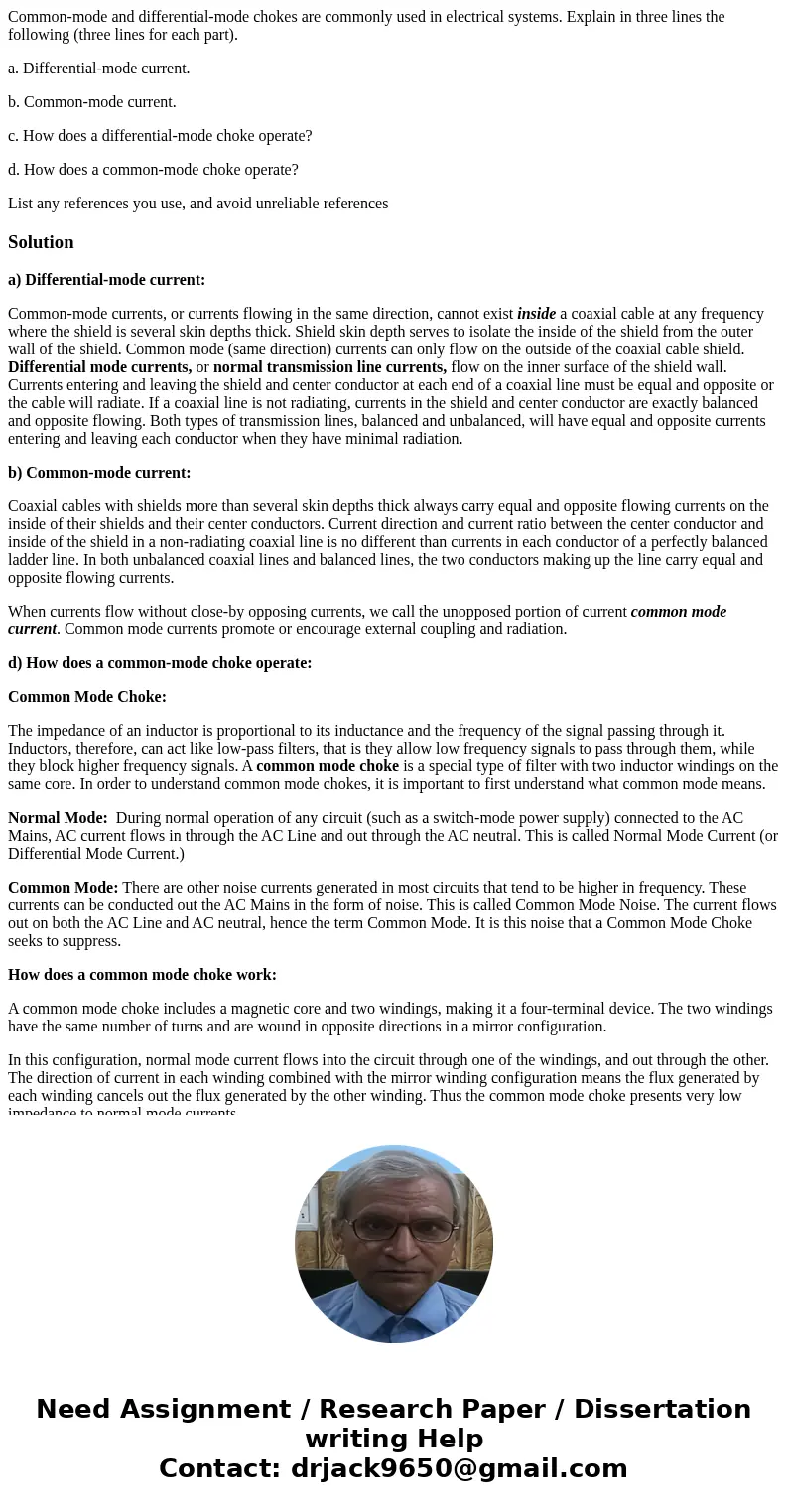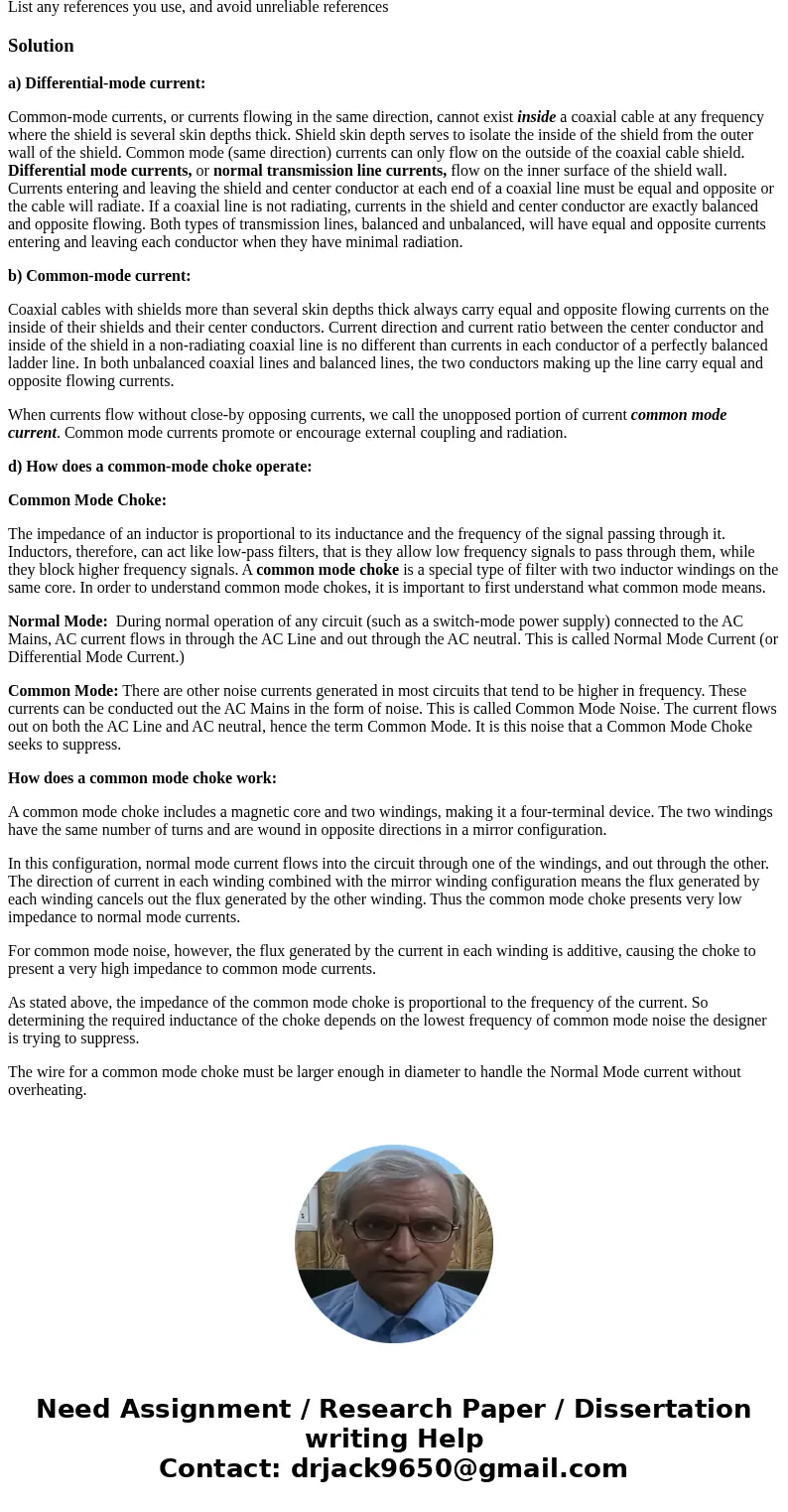Commonmode and differentialmode chokes are commonly used in
Common-mode and differential-mode chokes are commonly used in electrical systems. Explain in three lines the following (three lines for each part).
a. Differential-mode current.
b. Common-mode current.
c. How does a differential-mode choke operate?
d. How does a common-mode choke operate?
List any references you use, and avoid unreliable references
Solution
a) Differential-mode current:
Common-mode currents, or currents flowing in the same direction, cannot exist inside a coaxial cable at any frequency where the shield is several skin depths thick. Shield skin depth serves to isolate the inside of the shield from the outer wall of the shield. Common mode (same direction) currents can only flow on the outside of the coaxial cable shield. Differential mode currents, or normal transmission line currents, flow on the inner surface of the shield wall. Currents entering and leaving the shield and center conductor at each end of a coaxial line must be equal and opposite or the cable will radiate. If a coaxial line is not radiating, currents in the shield and center conductor are exactly balanced and opposite flowing. Both types of transmission lines, balanced and unbalanced, will have equal and opposite currents entering and leaving each conductor when they have minimal radiation.
b) Common-mode current:
Coaxial cables with shields more than several skin depths thick always carry equal and opposite flowing currents on the inside of their shields and their center conductors. Current direction and current ratio between the center conductor and inside of the shield in a non-radiating coaxial line is no different than currents in each conductor of a perfectly balanced ladder line. In both unbalanced coaxial lines and balanced lines, the two conductors making up the line carry equal and opposite flowing currents.
When currents flow without close-by opposing currents, we call the unopposed portion of current common mode current. Common mode currents promote or encourage external coupling and radiation.
d) How does a common-mode choke operate:
Common Mode Choke:
The impedance of an inductor is proportional to its inductance and the frequency of the signal passing through it. Inductors, therefore, can act like low-pass filters, that is they allow low frequency signals to pass through them, while they block higher frequency signals. A common mode choke is a special type of filter with two inductor windings on the same core. In order to understand common mode chokes, it is important to first understand what common mode means.
Normal Mode: During normal operation of any circuit (such as a switch-mode power supply) connected to the AC Mains, AC current flows in through the AC Line and out through the AC neutral. This is called Normal Mode Current (or Differential Mode Current.)
Common Mode: There are other noise currents generated in most circuits that tend to be higher in frequency. These currents can be conducted out the AC Mains in the form of noise. This is called Common Mode Noise. The current flows out on both the AC Line and AC neutral, hence the term Common Mode. It is this noise that a Common Mode Choke seeks to suppress.
How does a common mode choke work:
A common mode choke includes a magnetic core and two windings, making it a four-terminal device. The two windings have the same number of turns and are wound in opposite directions in a mirror configuration.
In this configuration, normal mode current flows into the circuit through one of the windings, and out through the other. The direction of current in each winding combined with the mirror winding configuration means the flux generated by each winding cancels out the flux generated by the other winding. Thus the common mode choke presents very low impedance to normal mode currents.
For common mode noise, however, the flux generated by the current in each winding is additive, causing the choke to present a very high impedance to common mode currents.
As stated above, the impedance of the common mode choke is proportional to the frequency of the current. So determining the required inductance of the choke depends on the lowest frequency of common mode noise the designer is trying to suppress.
The wire for a common mode choke must be larger enough in diameter to handle the Normal Mode current without overheating.


 Homework Sourse
Homework Sourse